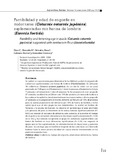| dc.rights.license | http://creativecommons.org/licenses/by-nc-sa/3.0/ve/ | |
| dc.contributor.author | Díaz Cuellar, Doraida R. | |
| dc.contributor.author | Briceño R., Rosa V. | |
| dc.contributor.author | Cabrera B., Héctor J. | |
| dc.contributor.author | González, Diomary | |
| dc.date.accessioned | 2009-09-09T21:13:26Z | |
| dc.date.available | 2009-09-09T21:13:26Z | |
| dc.date.issued | 2009-09-09T21:13:26Z | |
| dc.identifier.issn | 1315-3919 | es_VE |
| dc.identifier.uri | http://www.saber.ula.ve/handle/123456789/29368 | |
| dc.description.abstract | Se realizó un experimento para determinar la factibilidad y edad de engorde de codornices suplementadas con harina de lombriz (Eisenia foetida). Se utilizaron 54 codornices (Coturnix coturnix japónica), de un día de edad con un peso promedio de 7,28 gramos. El tratamiento 1 duró 6 semanas, el tratamiento 2 duro 7 semanas y el tratamiento 3 duro 8 semanas. Se les proporcionó a un grupo de 27 animales un alimento ad libitum con 19% de proteína sin harina de lombriz a los cuales se les aplicó los tres tratamientos antes mencionados; y al otro grupo de 27 animales se le proporcionó el mismo alimento ad libitum con 19% de proteína pero se sustituyó porciones del alimento por 12% de harina de lombriz y se les aplicó igual que al otro grupo los tres tratamientos. Se realizó un Análisis de Varianza y la prueba de duncan. Se observó en general que el peso promedio y la ganancia de peso se deterioran en la
octava semana significativamente (P<0.05); en relación al consumo de alimento, este aumenta, al aumentar el tiempo de engorde y la conversión alimenticia se desmejora significativamente (P< 0.05) en la 7ma y 8va semana. En general, el grupo de codornices suplementado con harina de lombriz no tuvo diferencias significativas (P> 0.05) con respecto al grupo que no fue suplementado, no obstante tienen un mayor peso y ganancia de peso. Se concluye que es factible el engorde de las codornices con harina de lombriz hasta la sexta semana de edad sin causar efectos detrimentales en los parámetros productivos. | es_VE |
| dc.language.iso | es | es_VE |
| dc.rights | info:eu-repo/semantics/openAccess | |
| dc.subject | Codornices | es_VE |
| dc.subject | Tiempo de engorde | es_VE |
| dc.subject | Alternativas alimenticias | es_VE |
| dc.subject | Harina de lombriz | es_VE |
| dc.title | Factibilidad y edad de engorde en codornices (Coturnix coturnix japónica) suplementadas con harina de lombriz (Eisenia foetida) | es_VE |
| dc.title.alternative | Feasibility and fattening age in qualis (Coturnix coturnix japónica) supported with earthworm flour (Eisenia foetida) | es_VE |
| dc.type | info:eu-repo/semantics/article | |
| dc.description.abstract1 | It was carried out an experiment to determine the feasibility and fattening age in quails supported with earthworm flour (Eisenia foetida). It was used 54 quails (Coturnix coturnix japonica), with one day of age with an average weight of 7,28 grams. The treatment 1 lasted 6 weeks, the treatment 2 lasted 7 weeks and the treatment 3 lasted 8 weeks. It was supplied to a group of 27 animals nourishment ad Libitum with a 19% of protein without earthworm flour to which the three before mentioned treatments were applied; and the other group of 27 animals was supplied with the same nourishment ad libitum with 19 % of protein but portions of nourishment were substituted by 12% of earthworm flour and as the other group it was applied the three treatments to them. It was
applied a variance analysis and ducan test. It was generally observed that the average weight and the weight profit deteriorated significantly during the eighth week (P<0.05); in relation to the consumption of nourishment, of course it increases while fattening time in increase and the nourishment conversion gets worse significantly (P>0.05) during the seventh and eighth weeks. Generally, the group of quails supported with earthworm flour did not have
significant differences (P> 0.05) in relation to the group which was not supported, however they have a larger weight and weight profit. It is concluded that it is feasible the fattening of quails with earthworm flour up to the sixth week of age without causing detrimental effects in the productive patterns. | es_VE |
| dc.description.colacion | 23-29 | es_VE |
| dc.description.email | ddiaz@ula.ve | es_VE |
| dc.description.frecuencia | anual | es_VE |
| dc.identifier.depositolegal | 82-0231 | es_VE |
| dc.subject.facultad | Facultad de Ciencias Forestales y Ambientales | es_VE |
| dc.subject.institutoinvestigacion | Instituto de Investigaciones Agropecuarias | es_VE |
| dc.subject.keywords | Quails | es_VE |
| dc.subject.keywords | Fattening time | es_VE |
| dc.subject.keywords | Nourishing alternative earthworm flour | es_VE |
| dc.subject.publicacionelectronica | Revista Agricultura Andina | es_VE |
| dc.subject.seccion | Revista Agricultura Andina: Artículos | es_VE |
| dc.subject.thematiccategory | Medio Ambiente | es_VE |
| dc.subject.tipo | Revistas | es_VE |
| dc.type.media | Texto | es_VE |



